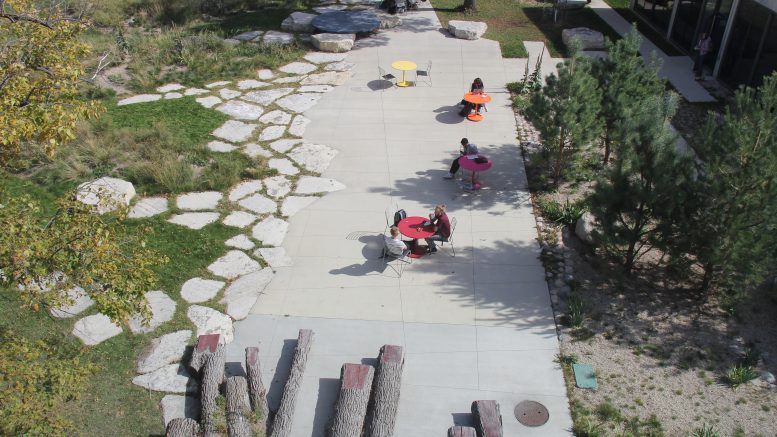The science courtyard sits behind the Armes lecture building, between Parker building and Machray Hall.
The outdoor space was designed by professors in the department of landscape architecture Anna Thurmayr and Dietmar Straub back in 2019.
“The last two summers, I was in the courtyard almost every week,” Straub said. “It’s such a pleasure to see how students, teachers, visitors, flowers and insects now inhabit the place. That’s the best feedback you can get as a designer.”
Their science courtyard project on the Fort Garry campus reflects the landscape architecture duo’s commitment. The courtyard serves as a classroom for Straub, weaving the geological history of materials into the fabric of students’ education. The stones, with tales dating back millions of years, become narrative tools for understanding Manitoba’s geological evolution.
“This helps me take students very far back into the history of our landscape,” Straub said.
This approach — integrating unconventional use of materials, community involvement and a commitment to ongoing engagement — characterizes the unique ethos of Straub Thurmayr Landscape Architects. The landscape design practice’s projects are small in scale, yet symbolize a means of initiating positive change and fostering a deeper connection between people and their environments.
Straub and Thurmayr trace their journey back to their meeting at the Technical University of Munich during their studies in the landscape architecture program.
Now a couple for 35 years, their successful collaborative work for design competitions led them to contemplate establishing their own firm. In 2000, Straub Thurmayr was born out of their shared passion.
When asked about their overarching vision, Thurmayr expressed a deep commitment to improving the world through their projects. Rooted in a desire to enhance the living conditions of all beings, their philosophy extends beyond typical design firm projects.
As professors and designers, they consider themselves agents for change in the face of global challenges such as climate change and social conflicts. The duo believes that their small-scale projects, though not capable of rescuing the world, can challenge existing norms and facilitate positive change.
Straub emphasized their outlook on projects, often pursuing research and experimentation. By encouraging openness and a willingness to take risks, they aim to transcend the conventional boundaries of landscape architecture and inspire a new perspective with their projects.
“They can really be seen as a catalyst for change,” Thurmayr said.
The duo shed light on their unconventional approach to projects, emphasizing the absence of a standardized method. Operating primarily on a pro bono basis, they collaborate with communities across Manitoba that lack the financial means to hire landscape architects.
Thurmayr and Straub embark on a journey of mutual trust-building with community members. The process involves preliminary designs, discussions and, in many cases, starting with minimal to no budget.
“There’s no money available, which I think can be great because this challenges your creativity,” Straub said.
Fundraising becomes a pivotal step toward realizing these projects, and Straub and Thurmayr explore avenues such as grant applications and partnerships with schools. The team also embraces an eco-friendly philosophy, seeking discarded materials for their projects — transforming the “worthless” into valuable components through recycling and upcycling.
Straub stressed the importance of challenging aesthetic norms, using unconventional materials that may not initially be considered aesthetically pleasing. He believes this approach contributes to a necessary shift in ethical considerations toward land use, fostering biodiversity and complex environments.
Notably, the duo’s projects never reach a definitive endpoint. Instead, they require continuous maintenance and attention. By involving community members and volunteers from the project’s inception, the two aim to create stewards for the landscapes, ensuring a sustained connection between the community and the space.
In contemplating the future of landscape architecture and urban design, Thurmayr and Straub acknowledged the challenges posed by multiple global crises. Despite the uncertainties, the duo emphasized the multifaceted nature of their projects as a means to instill hope for communal survival in an era of crisis.
The idea that initiated their journey as students — to improve the world — remains at the core of their mission. They envision creating little paradises collaboratively, fostering improvement through collective effort.
Straub stressed the need to relearn to inhabit environments with humility and modesty, particularly given the considerable carbon footprint associated with the construction industry and its contribution to climate change.
The duo highlight the role of plants as a foundational layer to address contemporary issues like climate change.
“I strongly believe in the power of the sun, the sunlight and chlorophyll in order to initiate changes,” Straub said. “It can be very, very simple.”
Their approach draws inspiration from the process of photosynthesis, where plants contribute to oxygen production while absorbing carbon dioxide.
This philosophy aligns with their larger vision to leverage the inherent power of plants, learning from the invaluable processes they offer. Straub said landscape architects should embrace and apply these principles to projects, contributing not only to the improvement of the environment but also to human well-being.
“There’s an inherent power to do something great without using too many resources,” Straub said.


